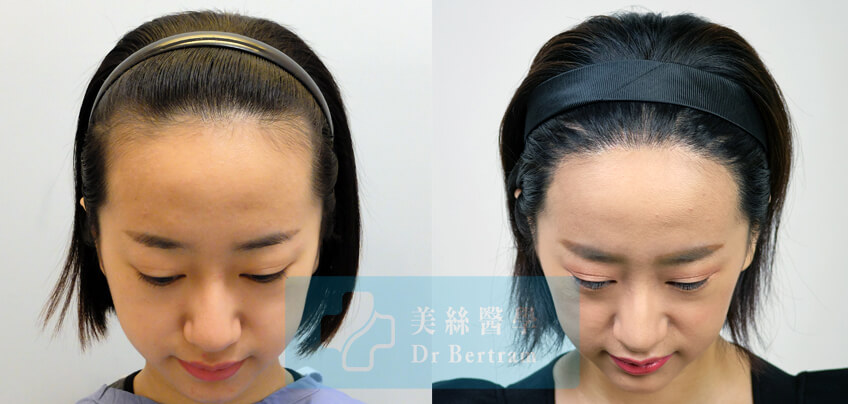- Hotline: 852+ 2891 9689
- Whatsapp: 852+ 9146 8426
- [email protected]
- 6/F 29 Austin Road, Tsimshatsui, Kowloon, Hong Kong

Hairline concerns aren’t just for men — many women notice thinning or a receding hairline over time. Understanding the cause can help you find the right solution. Here are the most common reasons:
The most common cause of hair loss in women, typically starting with thinning over the top of the scalp. In some cases, the frontal hairline also recedes, especially in women with a family history of baldness.
Repeated tension from tight hairstyles like ponytails, braids, or wigs can damage the hairline. This condition is especially common among women who style their hair tightly over many years.
A form of scarring alopecia seen mostly in postmenopausal women. It causes a band-like recession of the frontal hairline and may also affect the eyebrows. Early treatment is crucial to prevent permanent loss.
Hormonal shifts — from menopause, pregnancy, or thyroid dysfunction — can disturb the hair growth cycle, resulting in thinning or frontal recession.
Inadequate iron, zinc, protein, or vitamin D can weaken the hair and impair growth. Crash dieting or poor nutrition may accelerate hairline thinning.
Severe physical or emotional stress can trigger excessive shedding. While usually diffuse, some women experience more pronounced loss along the frontal scalp.
Some women are simply born with a high or uneven hairline. While not a form of hair loss, it can become more noticeable with age or facial changes — and often leads to hairline-lowering procedures for aesthetic reasons.
A high or M-shaped hairline may run in families. While it’s not always a medical issue, it can affect appearance and styling options, prompting many women to explore surgical correction.
Frequent use of harsh chemicals — such as dyes, bleaches, and relaxers — can weaken hair follicles, especially around the hairline.
Here’s a breakdown of which categories from the list above are suitable for hair transplant — and which typically are not:
Female Pattern Hair Loss (Androgenetic Alopecia)
✔ Most common indication
✔ Especially effective when hair loss is stable and donor area is healthy
✔ Works well for lowering the hairline or increasing density
Traction Alopecia
✔ Ideal once the traction cause (tight styling) is stopped
✔ Transplant can restore temples and frontal edges if scarring is minimal
Naturally High Hairline (Since Birth)
✔ Aesthetic correction is very common
✔ FUT often preferred as it avoids shaving the whole head
✔ Suitable for women with no actual hair loss but cosmetic concern
Genetic Hairline Shape
✔ Similar to naturally high hairlines — transplant can lower or reshape
Stress and Telogen Effluvium
➖ Not usually treated with surgery
➖ However, if stress-induced loss becomes long-term and stable, and hairline remains thin, transplant may be considered — only after recovery is confirmed
Hormonal Imbalance
➖ Surgery only once hormones are medically stabilized
➖ Uncontrolled thyroid issues or active hormonal fluctuations may lead to poor outcomes
Nutritional Deficiencies
➖ Treat underlying deficiency first
➖ Transplant considered only if hair loss persists after correction
Frontal Fibrosing Alopecia (FFA)
✘ Autoimmune and scarring
✘ Transplanted hair often fails to survive
✘ Surgery may worsen the condition
Chemical Damage from Hair Products
✘ Typically leads to temporary weakening
✘ Not ideal unless long-term damage has led to permanent thinning, which is rare

A naturally high forehead or receded M-shaped hairline can disrupt facial proportions and make styling difficult, especially for women seeking a softer, more feminine look. By applying the Golden Ratio of Facial Harmony (Da Vinci’s Rule of Thirds), we use hair transplant to restore balance and enhance appearance.
Hair follicles can be transplanted in three key ways:
Over 95% of women seeking hairline correction are good candidates — provided their donor hair is of reasonable quality. Candidates typically include:
Hair transplant offers permanent improvement and a more feminine appearance. However, expectations must be realistic and carefully discussed during consultation.
Most patients achieve excellent results in a single session. A small touch-up session may be recommended for further refinement.

Each hairline is custom-designed to match your face shape, age, and aesthetic goals. We aim for:
We offer both FUT and FUE methods depending on your hair characteristics, scarring concerns, and styling preferences:
Transplanted hairs are permanent and do not require long-term medication to maintain results. However, if female pattern hair loss (FPHL) exists elsewhere on the scalp, we may recommend:
At our clinic, we don’t use a one-size-fits-all approach. After years of study and real-world experience, we’ve come to a simple but powerful conclusion:
There is no such thing as a standard or arbitrary hairline.
The ideal hairline is already written in your own features — shaped by your facial proportions, hair texture, density, flow, and parting habits. This is why we treat each hairline as a unique fingerprint.
Instead of drawing artificial lines, our Female Hairline Extension Technique builds on what’s already there. We identify your natural hairline flow and extend it forward 1–2 cm, seamlessly blending the transplant with your existing hair pattern.
This technique ensures that the result looks natural.
To fully eliminate the masculine “M-shaped” pattern, we strategically fill the fronto-temporal corners (apexes) and ensure the transplanted hairs gracefully connect with your natural temporal lines.
We also plan around the parting side, as well as individual features such as:
These subtle elements are preserved, not erased, to ensure the final look is feminine, soft, and naturally matching your existing hairs.
The result was presented in International Spciety of Hair Restoration Surgery Annual Scientific Meeting San Francisco (2013) and in Taiwan Association of Hair Restoration Surgery Annual Scientific Meeting Taipei (2019). It was also published in ISHRS FORUM Medical Journal (2013).
Shock loss is a response to the trauma or stress of surgery. It affects not only the transplanted follicles but also the surrounding native hairs, especially those already weakened by:
Genetic thinning (miniaturization)
Hormonal imbalance
Nutritional deficiencies or underlying scalp inflammation
Recipient Area: Existing weak hairs near the grafts may fall out temporarily
Donor Area: Rare, but can occur if donor hairs are thin or if extraction is aggressive
Begins: Around 2–4 weeks post-surgery
Recovery: New growth usually starts by 3–4 months, with full recovery by 6–12 months
Most hairs regrow stronger than before, especially when supported by proper care
While it cannot always be avoided, we minimize shock loss by:
Using gentle implantation techniques
Avoiding overcrowding grafts
Pre- and post-operative use of nutritional support or low-level laser therapy (LLLT)
Sometimes pre-treating FPHL with minoxidil before surgery
In the vast majority of cases, no — the loss is temporary.
However, if the surrounding hairs were already severely miniaturized (i.e., close to falling out), they may not return.

it is important to realize that design and surgical restoration of a hairline for women is very different from that for men.

From consultation, surgery, to aftercare, you will receive continued personal care by our doctors, not just consultants.
Have a question? Please feel free to call our friendly customer service.
International Accreditations
Recognized by leading global medical bodies, our clinic stands as one of the most qualified and internationally accredited hair transplant centers in Hong Kong and mainland China. We are proud to uphold the highest standards in medical ethics, safety, and surgical expertise.
Hair transplant is the ultimate solution to restores hair, but not everyone is good candidate.
Our online assessment helps determine if these procedures suit you, saving you time and costs.